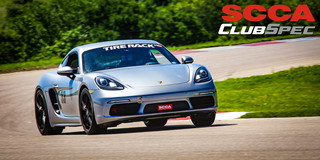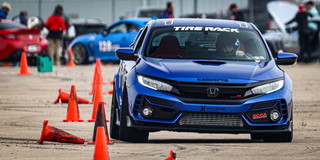
This article first appeared in the October, 2016 edition of SportsCar Magazine. SCCA members can read the current and past editions of SportCar digitally here after logging into their account; To become an SCCA member and get SportsCar mailed to your home address monthly in addition to the digital editions, click here.
First, a history lesson: Since I entered my first road race in 1985, the world of on-track competition has completely transformed. Back then, at the national level, it was SCCA and IMSA, and as far as I could tell from my vantage point in Florida, that was it. For club-level racing, it was SCCA or nothing.
For a long time, I had never even heard of a track day in one’s own street car. If they existed at all, they were not common. As far as I was concerned at the time, that would be an SCCA Solo I, requiring at least a roll bar and driver’s fire suit, and events were rare. In my own last minute, low-dollar, airheaded way, I struggled to move from the autocrosses I had run for years at 40mph averages, to lapping real racetracks at 80mph averages. But it wasn’t easy at all. The first time I stumbled upon an SCCA road race as I drove by, I was locked out, even though I was desperately interested. Later, I still didn’t know any racers very well; it was a totally different social circle. And there were many hoops to jump through at SCCA, all created with the best of intentions.
Further, SCCA Club Racing required a real racecar with intimidating levels of modification, or over in Showroom Stock, a nearly new car. I couldn’t begin to afford either, nor afford to destroy one in an on-track incident. Yet I yearned to get out there on track and see what I could do.
Back in those days, I went to the local stock car races a time or two; a small circle with burly American cars and drivers roaring their way around in quite a spectacle. I was astonished to learn the only requirement for driving in the races was the $10 ticket for general admission I held in my very hand. How is this possible, I marveled? This was definitely auto racing with all that it entails – yet any Joe or Josephine could walk up and drive in the race.
As the next decade came upon us, some marquee clubs like Porsche, BMW, and Ferrari began non-racing lapping days, usually known euphemistically as “driver education,” the now-ubiquitous “DE.” Those events later developed into their own club-level races, too. For some reason, the SCCA, which staged road races for years, never went the other way around and offered lapping days – to our great deficit. While an entire industry exploded in this middle ground between pylons and wheel to wheel, our SCCA did not stage such events until relatively recently: the PDX and now Track Night in America. This is a fabulous recruiting and farm system for our Club and even Pro Racing, and a very natural and easy step beyond Solo for those willing to accept the increased speed, risk, and cost.
As I’ve said before, our SCCA now has far more competition for motorsports participants, and we truly must broaden our horizons to survive.
Our esteemed National Board of Directors have recognized the potential of this style of event, and led by Director of Experiential Programs, Heyward Wagner, it’s happening. Night before last I did a Track Night again at Atlanta Motorsports Park, coaching friends registered in the Novice and Intermediate groups, then hot lapping in Advanced and autocrossing in the paddock; a veritable sports car extravaganza, I tell ya! The crowd was decidedly younger and more multi-ethnic than what we see at our usual events. It was a high-energy happening.
Another new universe of road racing choices began with a small group of automotive writers and an idea to stage a hilarious, cheapo, run-what-you-brung, bring-your-buddies slummin’ endurance happenings called the 24 Hours of LeMons. No experience needed. And it’s now a huge success, with a long list of spinoffs and imitators. It’s just so easy to get into, people, and the races are a real good time! Many, no most, new drivers are now going that route. Enter another Wagner brainstorm, the SCCA Bracket Enduro, one of which I recently had the pleasure to run at Sebring. Great fun, and seven hours of racing shared with two co-drivers.
At the same time, other forms of tire-burning competitions have sprung up and grown tremendously. Have you heard of time attack? This sport grew up in Southern California and is more like our Solo I of years gone by. Cars run a road race circuit in a group, but not for position; rather, they’re trying to log a single fast lap time. Some amazing machines have appeared in this form of racing, and a very young crowd, too, I might add. Rules allow radical modifications; turbos, all-wheel drive, huge wheels, fender flares, and wings.
And how about drifting? Isn’t power oversteer the best thing you can do with a car? I’ve written this myself: it’s a darned shame winning on pavement requires sliding a car very little, because tire-burning, slideways drama is tremendously entertaining. Wooo-hooo! We road racers only get to do it by accident or when something is really wrong with the car – or on victory laps, usually in doughnut form.
What is another factor underlying most of the above driving games? There is very little risk of getting crashed by a competitor, intentional or otherwise. With the exception of LeMons-type events, these auto sports involve no passing or on-track position. I see and feel a real sea change here. I have frequently been appalled at the damage inflicted upon one another at the races, including a couple of cataclysmic collisions that slid right under our announcers’ booth on the last lap of the Runoffs at Road America – on the straight. Perhaps younger generations are not so willing to take that risk? Perhaps younger generations are actually a bit more sensible? Both time attack and drifting attract a much younger crowd than I see at SCCA and even pro road races, and neither involves the aggressiveness of wheel-to-wheel combat.
My host and driving force behind the Sebring Bracket Enduro, Dana Deshong, spoke of removing barriers to racing in the SCCA. He is spot on, and one sharp fellow – another great asset to this Club. To bring SCCA into the 21st century, we need this kind of ease of entry. We need to treat entrants like customers, and provide products that are what they want, in an easy and entertaining way. At the bottom line of this, is the very survival of this august organization.
Words by: Randy Pobst
Image by: Dave Green










